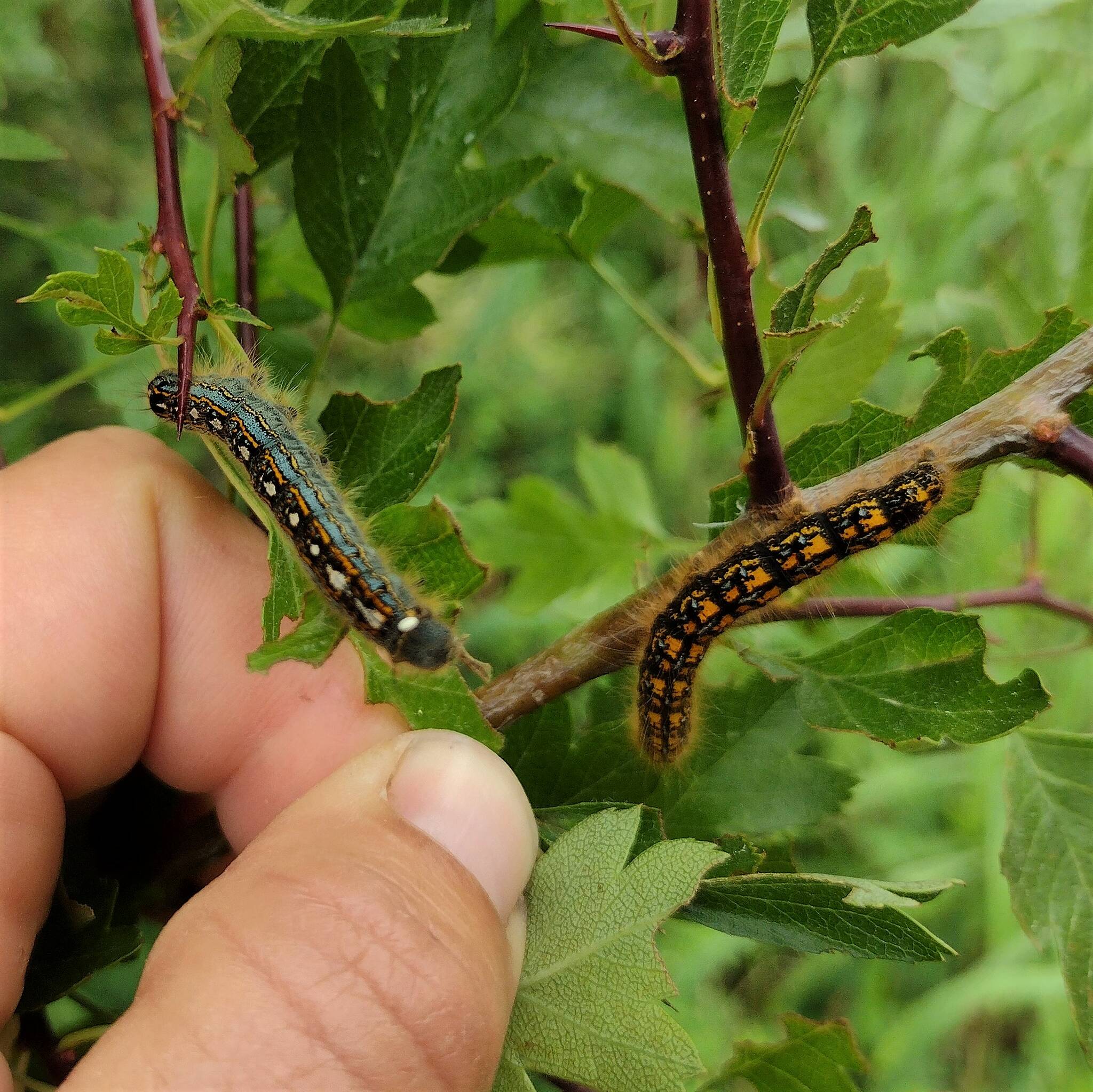Contributed by Madrona Murphy (Kwiaht).
By the time you notice tent caterpillar infestations, it’s too late to do much about them. The good news: you don’t really have to do anything. Your trees are going to be fine.
Our common tent caterpillars are larvae of the Western tent caterpillar moth (Malacosoma californicum), a native species that follows a dramatic boom/bust cycle. Its abundance peaks for about 3 years every 7-11 years. The last big boom in the islands was around 2012. During the peak years of each cycle they can completely defoliate deciduous trees, including wild crabapples, alders, and of course orchard apples and cherries; but nearly all of these trees will fully recover, typically putting out new leaves in June after the caterpillars have begun to pupate. Growth that year may be sluggish, and fruit production reduced, but defoliation alone will not kill mature trees. Have patience: aggressive pruning of defoliated branches can do more damage than the caterpillars.
Western tent caterpillar eggs are laid in late summer, but the caterpillars only emerge after trees leaf out the following spring. The eggs are laid in small brown foamy masses on the warm side of live young branches. If you find them when pruning, simply peel or scrape them off. (After removal, egg masses can be left on the ground; they will not survive.) As they emerge from an intact egg mass, caterpillars spin a “tent” of silk in which the entire brood shelters together. Several broods may share a single tent, moreover, which can increase survival and speed their maturation. Tearing or destroying the tents as soon as they appear will give birds access to the smaller caterpillars, reducing survival of the brood.
Tent caterpillars become less palatable to birds as they grow; and as their tents spread through a tree, removing them becomes more difficult and can do more harm to the tree. During non-peak years, a brood of tent caterpillars will generally feed on a single tree, only leaving to pupate. This year, tent caterpillars are so abundant they are running out of leaves and moving to new trees and shrubs before they finish their 30-42 day larval growing stage. When ready to pupate, caterpillars leave the trees or shrubs on which they have been feeding, cross lawns and fields, and climb up stems of grass (as well as fences or the sides of buildings) where they spin cocoons of white silk dusted with a yellow powder. Cocoons are often found in mature hay fields; indeed, cocoons in bales of hay may be one of the ways that moths and butterflies spread from the mainland to the islands.
In late summer, after about two weeks of pupation, inconspicuous brown moths emerge from tent caterpillar cocoons. These moths are nocturnal, non-feeding, and short-lived. They are attracted to light, but do not migrate. Because they emerge in late July and early August, tent caterpillar moths may be a food resource for bats, which are still nursing their pups at that time.
Tent caterpillars also attract a diverse suite of fly and wasp parasitoids. Tachnid flies lay small white oval eggs on the heads of tent caterpillars; when the caterpillar pupates, the fly larva consumes it and eventually emerges from the cocoon instead of an adult moth. The abundance of fly eggs lags slightly behind the tent caterpillars’ own boom/bust cycle—they increase in abundance during the outbreak and are most abundant as the caterpillars’ cycle wanes. When removing tent caterpillars from a tree, leaving those with fly eggs may help raise the next generation of parasitoids.
The main driver of the tent caterpillar boom/bust cycle is a nuclear polyhedrosis virus that spreads to epidemic levels when the caterpillar populations are densest. The moth-specific virus spreads by direct contact between caterpillars, and through caterpillars’ contact with the silk threads of the brood tent. Severely infected caterpillars hang limply from branches, either head down, or bent into a V-shape, and drip virus-laden fluids onto the caterpillars and silk below them. A large proportion of tents are infected with the virus this summer, which means that we are nearing the end of the current outbreak cycle.
The best way to support your trees during a tent caterpillar outbreak is to make sure they are generally healthy. Water young trees during droughts; provide adequate nutrients through mulching or applying compost; and prune out dead, damaged, and diseased wood. In the early stages of an outbreak you can limit the defoliation by removing caterpillar eggs, disrupting tents, and picking caterpillars off trees and shrubs. Avoid spraying pesticides as they will poison non-target insects, and may also have downstream impacts on insect predators that help keep tent caterpillars in check, such as birds and bats. Also bear in mind that Bt and other bacterial controls kill all butterflies and moths in the neighborhood—not just the tent caterpillars!
Once caterpillar tents are widespread and the caterpillars are more than an inch long, control methods will have little impact and patience is key.
Interestingly, this year’s tent caterpillar outbreak in the islands is different from the last one in 2012 in one important respect: in some areas, a second species, the forest tent caterpillar (Malacosoma disstria) is also present. This species is more widespread across North America than the western tent caterpillar, but not as common in the Pacific Northwest. Unlike their relatives, forest tent caterpillars do not make tents, but rather shelter on sheets of silk along tree trunks. They can be distinguished by a blue-gray stripe on their side, and a line of large black-and white dots on their back that resemble penguins when viewed from above. It is unclear whether the forest tent caterpillars will follow the same boom/bust timing in the islands as the more abundant western tent caterpillars. We are collecting specimens and monitoring trees to find out!



